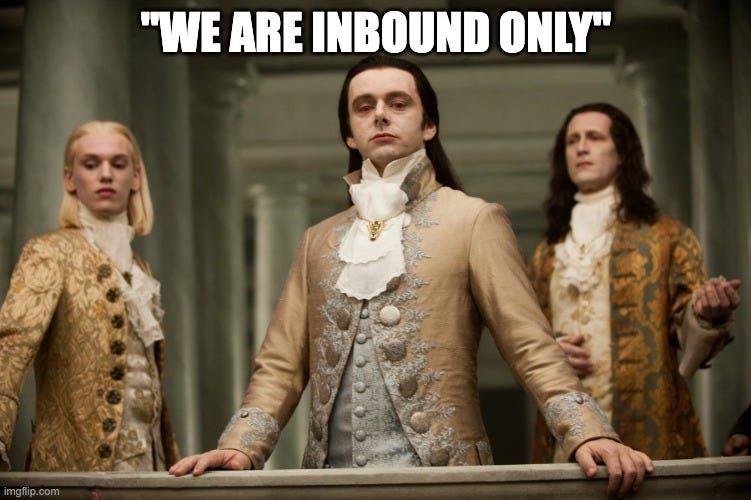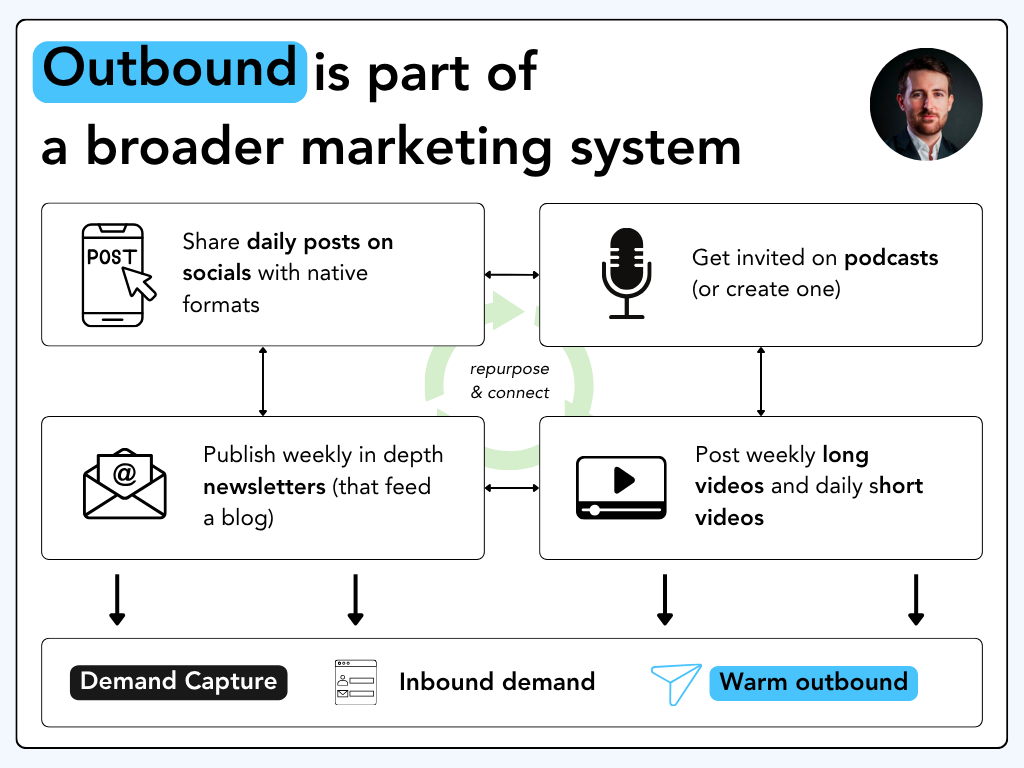Hello, welcome to this edition! 👋
One of the most misleading debates in marketing is this:
The opposition of Inbound vs. outbound marketing.
You’ll hear it everywhere. I’ve heard people say things like:
“Outbound is dead. Just create great content and let people come to you.”
“We are inbound only. Outbound is for spammers”
“Inbound is unpredictable, we do only outbound”
But while both camps argue over tactics, something far more important is getting lost:
Return on Investment.
So here’s what you’ll learn in this edition:
Problem 1: the false debate of Inbound vs. outbound marketing
Problem 2: most outbound workflows are bad
Solution: connect your outbound and inbound systems (the right way)
👋 If you want my help in your B2B business, here’s how I can help you;
1. The Authority-first Framework: My complete course to help you create your B2B content strategy and turn your expertise into content (for LinkedIn™, Newsletter, and YouTube).
2. My LinkedIn™ visual content agency: Work with me and my team to turn your expertise into infographics, carousels, videos, and text posts. Plus, we help you on your social selling to close deals.
3. 1:1 advisory with me: I’m reopening slots for my 1:1 advisory. I’ll help you to set up your entire B2B marketing and content strategy. Send me an email at hello@pierreherubel.com
4. Sponsor this newsletter: Promote your brand to my audience on this newsletter (and possibly elsewhere). Send me an email at hello@pierreherubel.com
Most marketers are leaving half their potential revenue on the table
The truth is, most marketers are leaving half their potential revenue on the table. Not because they chose the wrong channel… but because they’re only using half of the system.
They publish content... but don’t follow up.
They run outbound... but ignore buyer behavior.
They do everything, but don’t connect it into a system.
This is the inbound vs outbound trap.
And if you’re in it, you’re cutting your ROI in half. Let me show you how to escape.
Problem 1: The “we are inbound only” leads to a spray and pray approach (that kills your content ROI)
People love to say they’re “inbound only”.
That’s because inbound marketing feels good. You publish helpful content. You build an audience. People start liking and commenting. Maybe a few even book a call.
Here are the 2 main problem with being “inbound only”:
1. You are not maximizing the ROI of your content
Content might be working but you’re not maximizing your ROI. Because you’re not reaching out to people who engaged with your audience, you’re losing 50% (at least) of the potential deals.
A lot of people who LOVE your content and probably would want to work with you will NOT contact you. That can be because they’re busy or forget about it.
Let’s run the numbers:
You spend $10,000 on content.
That content drives $20,000 in revenue from inbound leads.
Those are solid numbers. But for every 1 person that books a call with you from your posts, dozens more are liking, commenting, and viewing your profile… then disappearing without taking action.
Your failure to follow up has left another $20,000 on the table.
On paper, your ROI is 2:1. In reality, it could’ve been 4:1.
They build attention… but struggle to convert it. They confuse publishing with prospecting. They forget that “building trust” only matters if you know what to do with it.
You don’t need more traffic. You need to better harvest the demand your content is already generating.
2. You are not reusing your content for 1:1 conversations
If you’re creating case studies and posting on LinkedIn and your blog, that’s a good start. But if you’re not sending them to engagers or profile visitors, you’re using only half of the potential of your content.
You need to maximize content distribution with outbound (and paid ads) as well.
Problem 2: The issue is not outbound, the issue is linear outbound sequences
Now let’s look at the other half of the trap: outbound done wrong.
B2B marketers are addicted to linear prospecting sequences:
They love to see the sequence mapped out → Control
They can track key rates (CTR, replies, clicks) → Tracking
They know exactly what's going to happen → Predictability
They sit down for a day and plan a series of emails → Convenient
But these linear sequences are not aligned with customer buying journeys:
1. The 'linear' path doesn't match the way people decide.
Humans (including B2B buyers) process thoughts in a non-linear way. Our thinking involves various cognitive processes such as intuition, association, or divergent thinking. Thus the B2B buying journey is a complex mix of time, repetition, brand exposure, and self education.
2. The timelapse of the sequence doesn't match sales cycle length
From first touchpoint to closing date, the B2B sales cycle length takes on average around 4-7 months. But most sequences push emails with 'next steps' in the span of 4-7 weeks. They often end up with "You don't want to buy, sorry I will let you go" only after a few weeks.
3. It doesn't align with standard human psychology
People don't like to be forced to do something, it's called psychological reactance (CF Steindl, et al., 2015). Yet, most sequences literally force the next steps with hard call to actions (e.g. book a call).
4. Most linear sequences are unpersonnalized spammy emails
If you’re trying to send generic emails to a large database and say “outbound doesn’t work”, it’s because you’re doing it wrong. People are fed up with random cold emails, so don’t even try this method.
Solution: Stop opposing inbound and outbound and start connecting them
Your biggest ROI leak isn’t a broken funnel.
It’s one that’s disconnected from the other parts of your funnel. Your inbound and outbound systems should not be separate from each other, but rather they are two parts of the entire system.
So stop choosing to do either inbound or outbound. Do both and connect them.
That’s how you multiply your ROI.
You can’t wait around for your content to do all the work. You should optimize for ROI by weaving outbound into your process and connecting your content to your sales system. The truth is, most marketers have no system for capitalizing on warm engagement.
This isn’t ‘inbound’ or ‘outbound’. This is a connected sales system that drives revenue.
When you stop opposing outbound and start combining them, you build a system that puts ROI first, not your EGO.
But of course, you need to run outbound correctly;
How to do outbound the way buyers actually buy
Outbound is not the problem. Linear sequences are the problem.
So here are 9 ideas on how to rethink outbound for 2025:
Use 'triggers' to send emails rather than a 'go in/go out' method
Understand deeply how your audience buys, and what they need to see, to buy
Include outbound tactics within a broader marketing system
Focus on the targets with intent rather than mass emailing
Use emails to deliver content matching the buying stage
Don't force the journey with aggressive calls to action
Go from industry-based to account-based targeting
See emails as a touchpoint among other ones
Put intent at the center of your outreach
The key is repositioning outbound within the buying journey, not as a separate activity that fights against your content strategy.
👋 If you want my help in your B2B business, here’s how I can help you;
1. The Authority-first Framework: My complete course to help you create your B2B content strategy and turn your expertise into content (for LinkedIn™, Newsletter, and YouTube).
2. My LinkedIn™ visual content agency: Work with me and my team to turn your expertise into infographics, carousels, videos, and text posts. Plus, we help you on your social selling to close deals.
3. 1:1 advisory with me: I’m reopening slots for my 1:1 advisory. I’ll help you to set up your entire B2B marketing and content strategy. Send me an email at hello@pierreherubel.com
4. Sponsor this newsletter: Promote your brand to my audience on this newsletter (and possibly elsewhere). Send me an email at hello@pierreherubel.com
Alright that’s the end of this newsletter. I hope it helped you! Thanks for reading :)
























Outstanding, as always.
Thanks for this, happy to see it available for free on the internet.
My first time reading about the non-conflicting state between inbound and outbound was in the book "Fanatical Prospecting".
Since then, I don’t understand why people are still focusing on one or the other.
Also, thanks for mentioning how to insert warm outbound inside inbound strategy based on engagement trigger.
It should be the default combo for every serious content creator on LinkedIn that wants to promote it services.
It’s just common sense!
(but common sense is not so common).
While I thoroughly loved the post, I'm curious how you create those graphics.